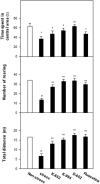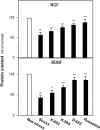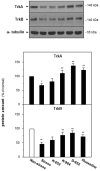Kai-Xin-San series formulae alleviate depressive-like behaviors on chronic mild stressed mice via regulating neurotrophic factor system on hippocampus
- PMID: 28469194
- PMCID: PMC5431115
- DOI: 10.1038/s41598-017-01561-2
Kai-Xin-San series formulae alleviate depressive-like behaviors on chronic mild stressed mice via regulating neurotrophic factor system on hippocampus
Abstract
Kai-xin-san (KXS) is a famous Chinese medicinal formula applied for treating stress-related psychiatric diseases with the symptoms such as depression, forgetfulness and dizziness. In clinic, the composition ratio of KXS is always varied and KXS series formulae are created. Here, we aim to compare the anti-depressive effect of different ratios of KXS and reveal its action mechanism on regulation of neurotrophic factor system. Firstly, daily intra-gastric administration of chemically standardized extracts of KXS series formulae for seven days significantly alleviated the depressive symptoms of chronic unpredictable mild stressed mice displayed by enhanced sucrose consumptions and decreased immobile time of forced swimming coupled with increased locomotor activities. KXS might fulfill this effect by up-regulating the expressions of NGF, BDNF and Trk receptors in hippocampus, which were confirmed by the treatment of corresponding blockers tPA-stop and K252a. The ratio with higher amounts of Ginseng Radix et Rhizoma and Polygalae Radix exerted most profound effect on anti-depression and regulation enzymes in metabolic pathway of neurotrophic factors. These findings suggested that KXS was beneficial for enhancing supplies, up-regulating receptors, and restoring the dysfunction of metabolic pathway of neurotrophic factors, which might account for its anti-depression effect.
Conflict of interest statement
The authors declare that they have no competing interests.
Figures








Similar articles
-
Kai-Xin-San, a standardized traditional Chinese medicine formula, up-regulates the expressions of synaptic proteins on hippocampus of chronic mild stress induced depressive rats and primary cultured rat hippocampal neuron.J Ethnopharmacol. 2016 Dec 4;193:423-432. doi: 10.1016/j.jep.2016.09.037. Epub 2016 Sep 20. J Ethnopharmacol. 2016. PMID: 27660009
-
Chinese medicine formula Kai-Xin-San ameliorates depression-like behaviours in chronic unpredictable mild stressed mice by regulating gut microbiota-inflammation-stress system.J Ethnopharmacol. 2020 Oct 28;261:113055. doi: 10.1016/j.jep.2020.113055. Epub 2020 Jun 24. J Ethnopharmacol. 2020. PMID: 32592887
-
Active components, derived from Kai-xin-san, a herbal formula, increase the expressions of neurotrophic factor NGF and BDNF on mouse astrocyte primary cultures via cAMP-dependent signaling pathway.J Ethnopharmacol. 2018 Oct 5;224:554-562. doi: 10.1016/j.jep.2018.06.007. Epub 2018 Jun 8. J Ethnopharmacol. 2018. PMID: 29890314
-
Efficacy of Chinese herbal formula Kai-Xin-San on rodent models of depression: A systematic review and meta-analysis.J Ethnopharmacol. 2024 Mar 1;321:117492. doi: 10.1016/j.jep.2023.117492. Epub 2023 Nov 25. J Ethnopharmacol. 2024. PMID: 38012974
-
[Research progress on antidepressant effects of Sini San based on three progressive levels of "single herb, herb-pair, and complicated Chinese herbal formula"].Zhongguo Zhong Yao Za Zhi. 2018 Jan;43(1):46-51. doi: 10.19540/j.cnki.cjcmm.20171106.014. Zhongguo Zhong Yao Za Zhi. 2018. PMID: 29552810 Review. Chinese.
Cited by
-
An Integrative Pharmacology-Based Pattern to Uncover the Pharmacological Mechanism of Ginsenoside H Dripping Pills in the Treatment of Depression.Front Pharmacol. 2021 Feb 15;11:590457. doi: 10.3389/fphar.2020.590457. eCollection 2020. Front Pharmacol. 2021. PMID: 33658934 Free PMC article.
-
Chinese Medicine, Succinum, Ameliorates Cognitive Impairment of Carotid Artery Ligation Rats and Inhibits Apoptosis of HT22 Hippocampal Cells via Regulation of the GSK3β/β-Catenin Pathway.Front Pharmacol. 2022 Jun 15;13:867477. doi: 10.3389/fphar.2022.867477. eCollection 2022. Front Pharmacol. 2022. PMID: 35784758 Free PMC article.
-
Pathogenesis of depression and the potential for traditional Chinese medicine treatment.Front Pharmacol. 2024 Jun 25;15:1407869. doi: 10.3389/fphar.2024.1407869. eCollection 2024. Front Pharmacol. 2024. PMID: 38983910 Free PMC article. Review.
-
Kai-Xin-San Attenuates Doxorubicin-Induced Cognitive Impairment by Reducing Inflammation, Oxidative Stress, and Neural Degeneration in 4T1 Breast Cancer Mice.Evid Based Complement Alternat Med. 2021 Jun 12;2021:5521739. doi: 10.1155/2021/5521739. eCollection 2021. Evid Based Complement Alternat Med. 2021. PMID: 34234834 Free PMC article.
-
Systems-level mechanisms of action of Panax ginseng: a network pharmacological approach.J Ginseng Res. 2018 Jan;42(1):98-106. doi: 10.1016/j.jgr.2017.09.001. Epub 2017 Oct 16. J Ginseng Res. 2018. PMID: 29348728 Free PMC article. Review.
References
-
- Christodoulou, G. N. Depression as a consequence of the economic crisishttp://www.who.int/mental_health/management/depression/wfmh_paper_depres... (2012).
-
- Skaper, S. D. The neurotrophin family of neurotrophic factors: an overview. Neurotrophic Factors: Methods and Protocols 1–12, doi: 10.1007/978-1-61779-536-7_1 (2012). - PubMed
Publication types
MeSH terms
Substances
LinkOut - more resources
Full Text Sources
Other Literature Sources
Medical
Molecular Biology Databases

